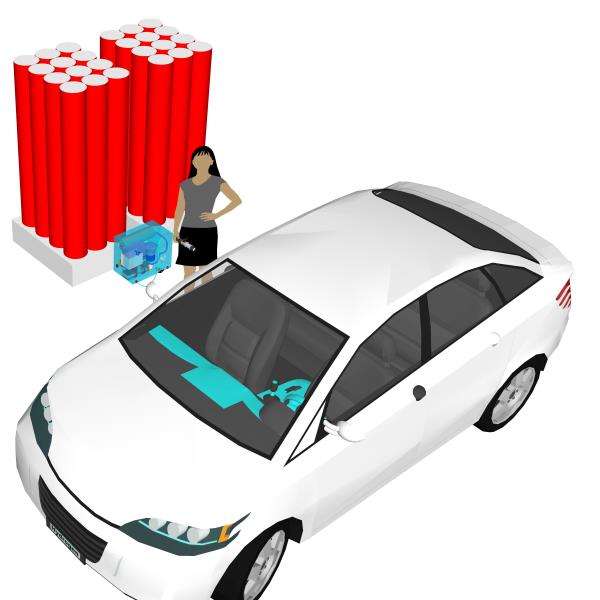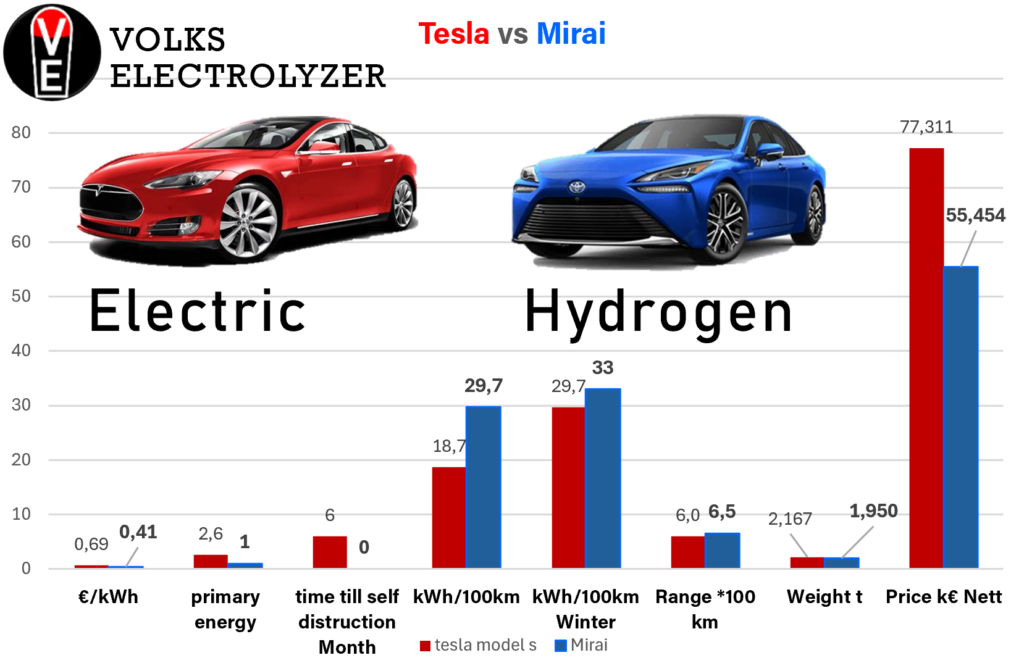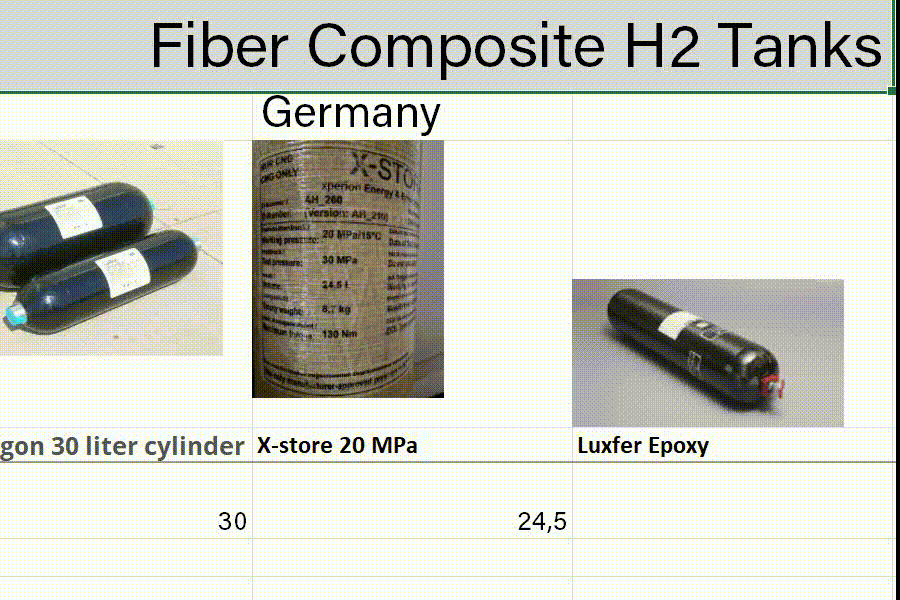The Tesla Model S and the Toyota Mirai hydrogen are beautiful cars. I invite you for test drives, where we travel through the history of mobility.
We compare technical data and make energy quantities comprehensive, while we check out alternative modes of transportation and their vehicle weight per person.
Mr. Musc was surely right, when he stood for the dominance of battery electric vehicles towards combustion engines. But one question was ignored:
Where does the electricity come from?
Today we talk about the new tesla model s versus the toyota mirai. On one hand side, we are taking a deep dive into technology and on the other side we are looking at mobility as such. Because even though a car is much more than just a mode of transportation, the purpose mostly is to reach a destination in a comfortable way.
The Style of this hydrogen electric car review
I am not paid for a car review, and I do not intend to copy a glorifying commercial style of typical car reviews. The result is going to be very surprising. The topics will change between the test-drive with the Tesla Model S and the Toyota Mirai concerning the broad idea of mobility from bikes over the first production car, the Ford Model T, Trains, autonomous driving and shared mobility.
At the end I will share my personal opinion on mobility and these two cars.
The history of Transportation
The history of mobility is a fascinating journey through innovations and technological advancements, significantly impacting the weight of transportation modes per person. Let’s explore this progression:
We are skipping walking, horseback riding and carts.
The bike
The invention of the bicycle in the early 19th century revolutionized personal mobility. Early bicycles, such as the penny-farthing, weighed around 15-20 kg. Modern bicycles average about 10-15 kg.
The advent of motor vehicles like the Tesla Model S
The Toyota Mirai is lighter than the Tesla Model S. With 1950 kg about 200 kg less. Quoting Wikipedia the Ford Model T had a weight around 600 kg. Theoretically the Mirai comes to 487 kg per Person, if you consider this a 4 Person Vehicle. This is 25 times the weight of a bike for instance.
Statistically only 1,5 person drive these 4 Person vehicles. This results to 1300 kg per person
Energy and Money
An electrical vehicle driver pays around 65 cents per kilowatt hour at a charger with an acceptable load.
The most expensive hydrogen you find at the airport, where you pay 50 cents per kilowatt hour.
Sustainability, where does the energy come from
The primary energy factor for electricity is not co2 neutral, because when you charge this electric vehicle in winter it is most likely energy from fossil fuels which has a primary energy factor of 2.6. This means you need 2.5 kWh of coal or gas to fill the EV with 1 kWh.
Same goes for hydrogen. The hydrogen at the gas station is likely from methane steam reforming. Quoting the ministry for ecology the primary energy factor is 1.2, still half as bad as fossil electricity.
The Idea of hydrogen as an energy carrier is to use the energy of the sun, right now it is Summer, to convert the electricity to hydrogen through electrolysis, and then use it whenever we need it.
Of course, you can say I don’t have a hydrogen refueling station around me. But we developed the Volks Electrolyzer to show that it is possible to have a home refueling station with a minimal investment.

Efficiency of electricity vehicles in Winter
In summer the Tesla Model S needs about 18.7 kWh for 100 km.
I found an interesting study by the German automobile club, which says that 29.7 to 30 kWh are used in winter by the Tesla Model S.
Quality of engineering
The Tesla Model S is built with an aluminum body which is amazing.
What I like about Tesla is their guts to rethink automobiles. Like the completely flat and closed under floor. So aerodynamic, whereas the Toyota still has the uneven look from beneath.
Both cars look absolutely beautiful. The Toyota has a bit more clearance for rough roads, though.
But honestly, there are two major drawbacks to the Toyota Mirai:
- It has no trailer coupling or towing hitch option
- There is no way to fold down the back seat, to transport or sleep in the car.
The Tesla has a camper mode where you can sleep in the car and watch a movie. I think that is pretty cool!
The Mirai’s body is from good old steel with optional corrosion. 😉
While you won’t see anything under the hood of a tesla model S other than charging cables, the bonnet of the Mirai unveils a precious secret. You can easily unclip the cover to repair the car. You can change an aggregate like the Webasto preheater made in Germany. This limousine doesn’t lack any comfort like vented seats. This pipe must be the ac. The Mirai has a normal heat exchanger where the heat of the fuel cell is either exchange with outside or heats the inside.
There are 3 700 bar carbon fiber cylinders in the construction holding 5.6 kg of hydrogen with impressive 184 kWh of energy stored. The reason for the unfoldable back seats is the 1.2 kWh Lithium battery next to the single motor. With 134 kW Power you reach top speeds of most highways worldwide.
The air is filtered and pressurized through something like a turbo charger. Inside the fuel cell the air meets the membrane of the fuel cell stack. On its opposite side the hydrogen travels through the membrane to form water with the oxygen. Heat and electricity are the benefit. The coolant flows around every cell off the stack and must be quantified depending on the user’s gas pedal behavior like air and hydrogen instantly. Amazing isn’t it.
The technology of a Tesla is pretty thin. Under the hoods aren’t really interesting things. The difference between winter energy consumption comes with the fact that even though the three motors of the model S are liquid cooled no heat can be recovered.
Driving experience of the Mirai versus the Tesla Model S
The acceleration of the Toyota is awesome. I love this sound from the ventilation system for the fuel cell. That’s what you hear when I accelerate like stupid just to get to the next red light.
The Tesla is so beautiful in a traditional way from outside and innovative inside.
Renewable energies intermit a lot in climates 40 degree North and south onwards. Maybe Matt Farell from the amazing tech YouTube channel undecided will make a video about his autonomy with his Tesla roof, Tesla Powerwall and car. The power wall has approximately 15 kWh while the car has a capacity of hundred. You might see that the dream of autonomy and cheap electric driving is a myth.
Renewable energy cannot deliver supercharger loads whenever the driver needs. That is why electric vehicle drivers pay the most for their electric energy.
The new design of the Mirai 2 shows the expression which comes with the vehicle. A strong, luxury car for innovative personalities.
But let’s get to the facts right now.
To have a hydrogen home refueling station is affordable. It doesn’t mean that it automatically serves all you need for transportation, but it might serve as a useful load for peak overproduction for your Renewables and maybe you’re lucky and you find a hydrogen refueling station around your place.
I like the Toyota Mirai, it’s much more like a usual petrol car.
You have to switch the car off and then push this button to mechanically open this refueling nozzle cover. This hydrogen refilling nozzle you have seen many times. This is the hydrogen pistol. It can be quite cold, when the hydrogen station is used a lot. You can see the condensation and even ice. You click the hydrogen pistol on the nozzle and refuel it for right now € 16.75
Let’s check out what technology is behind a hydrogen refueling station. We see two huge 10 m high hydrogen cylinders. it can’t be high pressure in my eyes. We see a lot of waste of heat by this cooling tables of the compressors.
There is an emergency switch, fire extinguishers all over the place and I guess this concrete wall is also for safety.
So as easy as that: if you have a hydrogen truck you go to the 350 bar nozzle and if you have a vehicle like the Toyota Mirai here then you go to the 750 bar nozzle and you just wait until this procedure is over. Refueling hydrogen might take a little longer than gasoline
Technical data of the Tesla Model S

To sum it up you pay 69 Cent/kWh for the Electric vehicle whereas you pay 41 Cent per kWh for the hydrogen vehicle.
The primary energy factor for excess power for hydrogen electrolysis is one. You lose no energy, and you gain hydrogen. But the primary energy factor for electricity in winter is 2.6 at least from fossils. Electric vehicles are not CO2 neutral
The hydrogen car might also die from a dead battery but an electric car will self-destruct itself by standby loads and chemistry. The Tesla seller said he has to ask his foreman if I can leave the car 6 months unattended and they wouldn’t suggest that more than 2 months.
The range of the Toyota Mirai is 650 km whereas the Tesla Model S has 600 km range. The Toyota Mirai is lighter slightly smaller and the price which could be an argument is mentionable €
20,000
less then the Tesla Model S
Also pricewise the Toyota Mirai won.
I think for what the Toyota Mirai won the most is, it is a car it is an engine it is engineering it is fine art it is the top technology it is the future technology and it is Cutting Edge. To master a fuel cell in a way that it works so Charming like in this car I don’t reckon anything is beautiful.
We can have hydrogen for almost free just from Excess power and this car just feels like a car.
It has only 130 kW power which makes you drive less than I think 175 km an hour but who cares. Look I cannot even pass a bicycle sometimes in the city traffic. What do I need several 100 kilowatt of power. that is just nonsense. Because all we know is e is energy and Einstein said e is equal to M * c² where m is the mass and C is the acceleration.
So if we have a powerful motor and we accelerate a lot the energy quadruples. In times where we have to convert from a very rich energy form to a less dense energy form I think uh we shouldn’t think about power as a necessary thing. But of course still if you are car enthusiast – I’m happy for you if you have a powerful car I don’t want to take your pleasure. There are many ways to reduce emissions in other sectrors.
Mobility
If we get back to the beginning, that mobility serves getting from one point to another in a comfortable way we should take trains into account.
Train
I will now show you some alternative modes of transportation to the personal car.

Cab
My most wasteful solution could be a hydrogen cap flat rate, like this lovely looking lady obviously has.
Autonomous driving
The reason I tell you about alternative ways of transportation, is that from a renewable perspective we need a shift in transportation and mass per person.
That should not mean suffering or horse carts.
Autonomous driving could bring more comfort and less personal cars like this Mobility solution idea from Volkswagen’s sister Moia. They are driving around Hamburg like crazy right now, to make sure it’s safe
Shared mobility
There are many ways of Mobility like this car sharing company called Miles.
You can rent the cars by app whenever you need it.
Micro car
The Opel E-Rock
In German we call it “Knutschkugel” which literally means kissing bubble or kissing ball. I think they all have the same micro car like Citroen and everyone has now one of those small an light Urban Mobility Vehicles which are of course more efficient and totally enough for dry transport in the city.
Personal opinion about the Tesla Model S
I would never buy a heavy car for personal transportation and that’s my explanation why. On this graph I put the modes of transportations over time. just skipping the horse wagons. The bike in the early 19th century was a revolutionary invention which allowed us with 15 kilograms of engine or bike per person we could drive with 1 kilowatt hour power with our human 100 watt power which is very healthy to use it from time to time 100 kilometers. This was very good but of course we were striving for more comfortable ways to travel. Then came the Ford Model T, the first production car, which was revolutionary because then also bike drivers could afford cars. It was very light because it was very basic. It was a five-seater, but we take the statistic 1.5 persons per car. The Ford Model T was very inefficient with 100 kilowatt hours or 10 L of gasoline per 100 person kilometers. It was very inefficient, which we see here in Orange the kilowatt hours per 100 person kilometers. Then came the average cars. Like the Model S and the Mirai which had like 20 kilowatt hours per 100 person kilometers and a weight of 2,000 kilogramms. That is absolutely nonsense if you have 1,438 kg per person of vehicle. Of course you have AC and all the convenience. You can load in your family or not but it’s very inefficient. I want just to remind you that back in 1990 we already had a car which was a 3 l diesel engine which was very small and Light which had 20 kilowatt hours per person and 100 Kilometers. There was no improvement between let’s say 1990 and 2024 in case of mass. If we go back to Einstein’s equation which was E equals mass time acceleration Square then we could go down with the mass to reduce the energy consumption but as we had the gasoline just been pumped out of the ground and we had it all we went on a tangent. This is no accusation! We went up with the mass and we wanted powerful cars. This car in 1990, no one bought it. I talked to car Sellers, and they said yeah it was a nice example for Energy Efficiency but actually no one wanted a small light non-comfortable car.
If we want to convert from 10 kilowatt hours per liter of volume to 0.003 kilowatt hours per liter volume of hydrogen non-compressed then we should think of reducing the mass. Actually we already did this because the ICE the shinkansen or the tgv which are just a couple of example of very fast and comfortable trains in this world have a weight about 400 tons I think and can take up to thousand passengers which sums up to 400 kg per person and an efficiency of 12 kilowatt hours per 100 person kilometers which is very comfortable.
Where else I can drink a coffee in a
train and I can go to the toilet? Only camper cars could do that and not even while they’re driving.
In my eyes the train the most comfortable fastest way of transportation.
For the short distance I’d like to have shared bikes at every station. If I have once in a while to buy something from Home Depot I want a car sharing car. I want to increase the efficiency in terms of used space per drive. I can drive with a heavy car and load it up so that I have a better ratio of usability and potential of the vehicle.
If you share that opinion, please share out content. If you disagree with this idea of reducing weight and going down a little bit of non necessary Comforts, then please leave us a comment down below and tell us what we Engineers can make better.
The price for a new Mirai is like a used Tesla Model S
| MOTOR | Mirai | Mirai Executive | Mirai Luxury | Mirai Advanced |
| Brennstoffzelle, Elektromotor mit stufenlosem Automatikgetriebe, Leistung: 134 kW (182 PS)* | 65.990,– | 69.090,– | 75.290,– | 76.290,– |
| netto | 55454 | 58059 | 63269 | 64109 |
| VAT | 10.536 | 11.031 | 12.021 | 12.181 |
You can also see the prices of other hydrogen vehicles in the international hydrogen pricelist if you become a community member
